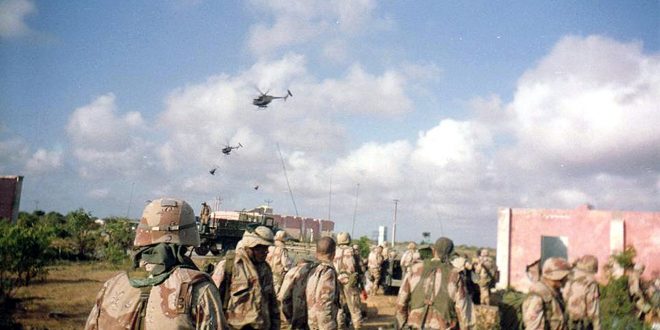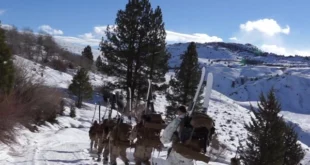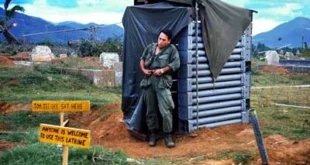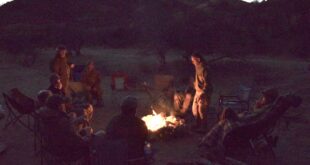Soldiers reflect on Battle of Mogadishu
By Nick Duk
On Oct. 3, Soldiers from across Fort Benning came together to mark the 21st anniversary of the Battle of Mogadishu with a Maneuver Center of Excellence leader professional development event.
The event saw eight veterans of the battle and one member of Task Force Ranger who served as a casualty assistance officer take the stage at Marshall Auditorium to share the experiences they had and the lessons learned during Operation Gothic Serpent.
On Aug. 23, 1993, Task Force Ranger flew into Mogadishu, Somalia, and began operations primarily to capture or kill Somali warlords who were jeopardizing humanitarian relief efforts. On Oct. 3, 1993, Task Force Ranger conducted a raid in order to capture high-value targets associated with warlord Mohamed Farrah Aidid.
The LPD began with a clip from the film Black Hawk Down, which showed the early stages of the mission up until Rangers prepared for a fast-rope insertion near the target building.
“I remember the dust that had been kicked up from the lead birds going in was so bad that we couldn’t even see the ground,” said retired Master Sgt. Norm Hooten, a member of the assault force. “I thought we were roping, so I threw the rope and stepped off and I was on the ground. It was a two-foot fast rope. We started clearing and it was over with within a minute. … We had captured the 12 guys we were supposed to get.”
Special Operations Forces assaulted the target while Rangers cordoned the area around the objective. The plan was for a ground reaction force to move to the target building to extract the personnel on target with the HVTs.
One Ranger, Pfc. Todd Blackburn, was injured when he fell from a helicopter during insertion, and had to be evacuated. Shortly after that, a Black Hawk designated Super 61, piloted by Chief Warrant Officer 3 Cliff Wolcott and Chief Warrant Officer 3 Donovan Briley, was shot down by a rocket-propelled grenade.
Hooten said the expectation coming in to the mission was that the Rangers would not be on the ground for very long.
“I was waiting for exfil and I was moving up to the roof when the bird was shot down,” he said. “I remember watching that thing go in, and it was real clear from the roof where it went in. I knew then this was going to be a little bit longer than a 30-minute operation. But, at that point, I didn’t know exactly how bad it was going to be.”
Selected members of the ground reaction force evacuated the injured Blackburn and the HVTs from the area while all remaining personnel on the ground attempted to reach and secure Wolcott and Briley’s crash site.
Retired Maj. Jeff Streucker led that evacuation convoy, but was the most experienced Soldier in terms of navigating Mogadishu, making it more difficult for the remaining forces to locate and navigate to the crash site.
“We made a mistake on the ground in the Humvee and didn’t share the load in land navigation,” Struecker said. “I think most guys thought, ‘Five major roads, who can’t figure out your way around the city with five major roads?’ … When you get in this, it gets real hard real fast.”
“Once we got on the ground, that real clear overhead view of the city became a maze of shacks and garbage,” Hooten said. “Trying to navigate through that was pretty challenging. We moved up and started taking our first serious casualties. I remember what that did to us as a unit. It demoralized me to the point that what it really did was infuriate me.”
A combat search and rescue team was inserted at Super 61’s crash site by a Black Hawk designated Super 68. Super 68’s pilot was then Chief Warrant Officer 3 Dan Jollota, who was able to allow the team to reach the ground despite being hit by an RPG during insertion.
“An RPG has a very unique sound,” Jollota said. “There was no doubt in my mind I had been hit by something pretty heavy. Fear took over, so I immediately took in power and I was getting out of there. My crew chief in the back saved the Rangers’ lives. He screamed at me, ‘Sir, you’ve got to stop. We’ve got Rangers on the ropes.’ These poor guys were hanging on to the fast ropes for dear life as I picked this thing up to a hover. The crew chief talked me back down into the hover hole, we got those Rangers off and we took off.”
Despite being hit by the RPG, Jollota was able to fly the damaged aircraft back to the U.S.-controlled airfield.
Twenty-eight minutes after Super 61 was shot down, the Black Hawk designated Super 64 and piloted by Chief Warrant Officers 3 Mike Durant and Raymond Frank took an RPG to the tail rotor and crashed about a mile from the first crash site.
Retired Brig. Gen. James Nixon, then a liaison officer to the 10th Mountain Division, said that was the moment the day took a turn for the worse.
“If you lose momentum in combat, you have to bleed to get it back,” Nixon said. “That’s the reality. If you lose tactical momentum, you bleed a little bit. If you lose operational momentum, you bleed more and if you lose strategic momentum, you bleed a lot. When the second aircraft went down in Somalia, we lost momentum. The way we were able to regain momentum was through bleeding for it and through the valor of the members of Task Force Ranger.”
Two snipers, Master Sgt. Gary Gordon and Sgt. 1st Class Randy Shughart, were inserted at Super 64’s crash site in an attempt to defend crash survivors.
Meanwhile, Struecker was tasked with putting together a convoy to travel to the Durant crash site and rescue any survivors.
Struecker had taken heavy fire while driving the initial evacuation convoy.
“Everything inside of me was saying don’t do this,” he said. “Don’t do this because you’re going to get every one of your men killed if you go back out there. Personally, I was thinking it was a suicide mission. If I drive back through what I just went through, I’m going to die in the next few moments, no question about it.”
Struecker credited Nixon with giving him the inspiration to return to the fight.
“He said, ‘Any idiot can go in on a hot landing zone the first time. But, it’s asking guys to go back into the exact same LZ after they’ve already been there and after they know how dangerous it is, that takes real courage and takes real leadership skills. You need to get your men ready for what we’re about to ask them to do,'” Struecker said. “It was almost as if God was preparing me ahead of time for one of the conversations that you see in the movie Black Hawk Down. Just a couple of minutes later, one of my guys walks up to me and says, ‘Sergeant, I can’t go back out into the city streets with you. I’m married and I know I’m going to die if I get back on those Humvees. None of us should be alive right now. ‘ I looked him in the eye and I told him I knew he was scared. All of us were. … The real difference between a hero and a coward is not fear. It’s what you do when you are afraid that makes a difference. I could have ordered him, but I didn’t. I said, ‘I’m not going to make you do this, but I need you on those Humvees. The rest of the guys who are on the city streets fighting for their lives – they need you.’
“I turned around, exactly like you see in the movie, and I watched in my rear view mirror as he reached down and picked up his squad automatic weapon, jumped in the back of the Humvee and spent the rest of the night in the city streets with me. Never have I been so proud of a warrior like I was that day because he was essentially saying, ‘I will go give my life up for the guy to my left and to my right who are still out in the city streets.'”
That convoy never reached the crash site of Super 64, as it was eventually overrun. All personnel, with the exception of Durant, were killed. Durant was captured by Aidid’s militia. For their actions, Gordon and Shughart were posthumously awarded the Medal of Honor.
It was not known until later that all personnel at Super 64’s crash site were lost. In fact, Jollota returned to the fight in a new aircraft to search for any sign of survivors.
“The Soldier in me is always very optimistic that everyone is OK on the ground,” Jollota said. “So, when I analyzed Mike Durant’s site, I believed that those guys had successfully landed their aircraft and gotten out of the aircraft. I believed they were moving from their crash site … I spent the rest of the night … flying over that city, getting rocked by RPGs, looking for those guys only to find out later that the Somalis had found their radios and turned them on to give us false indications.”
Meanwhile, the initial assault force eventually reached the first crash site. There, Hooten said the CSAR and the helicopter crew was in dire straits.
“I could see the tail, but I didn’t know what was going on inside of it until I was called up by then-Capt. Scott Miller to go into the aircraft and see if I could help with the recovery,” Hooten said. “What I found was they had inserted a CSAR team and almost everybody on that team was wounded. … What was there didn’t even look a like a helicopter. It was just a pile of rubble.”
The personnel at the site remained under heavy fire, and were trapped for the night.
Ultimately, a multinational force of Malaysians, Pakistanis and members of the 10th Mountain Division were able to mobilize a relief convoy that arrived at the first crash site around 2 a.m. Oct. 4. By 6:30 a.m., all U.S. forces had been evacuated.
During the operation, 18 U.S, service members were killed in action. Between 800 and 1,000 enemy forces were estimated to have been killed. After 11 days in captivity, Durant was released.
A common theme from those involved in the battle was the power of the personal relationships that had been forged before the battle and strengthened once challenges arose.
“These personal relationships that you develop throughout your military career are going to pay off in ways that you would never expect,” said retired Col. Ron Russell. “You will see it over and over and over again throughout your careers – it’s all about personal relationships.”
“Personal relationships made me commit myself to the guys on the ground,” Jollota said. “I knew we had just put our guys, our Family, on the ground in Mogadishu and we had to get back out there and help them. There was nothing that could be disputed in the fact that it was our job to help get them out.”
Retired Command Sgt. Maj. Tony Copper said the trust the members of the task force had built in one another in the weeks prior wound up being key.
“I can’t tell you how many (situations I had been in) previously … there had been a lot of what I call stovepiping, where information isn’t necessarily shared,” he said. “Here, working as one task force, we broke those barriers down. We didn’t stovepipe. We didn’t contain critical information – we shared it with each other. That was critical in making us a better fighting force.”
Nixon echoed Copper’s sentiments, saying trust is a vital element of the decision-making process.
“We have to make decisions based off of the information we have at the time,” Nixon said. “We’re not going to have all the information, so we have to make that decision and move on. Key to that is the relationships we build in training and in combat so that there is a level of trust. At any site, if there had been a different level of trust, it could have easily forced me into another decision that could have been catastrophic.”
Maj. Gen. Scott Miller, now the MCoE commanding general and then the leader of the assault force, told the Soldiers in attendance at the LPD that the battle helped to show him the importance of precision fires.
“If you’re a lieutenant, sergeant, captain or anybody who thinks they’re going to go fight somewhere, you better understand your communications,” he said. “You don’t step off anything without having a way to reach up and touch your fires. If you don’t have a way to reach up and touch your fires, you’re on the wrong battlefield right off the bat.”
Russell said for him, the battle re-emphasized the importance of mastering the basics.
“When things change and you haven’t rehearsed for them, haven’t planned for them and haven’t thought about them, the basics are what will carry you through the day,” he said. “The good news was the elements we had in this particular fight had the basics down to a degree which has been unparalleled by any other force. They are the finest ground forces and the finest aviators in the Army, and that’s they way they accorded themselves on this particular day.”
Hooten, meanwhile, said he took from the battle a belief in the importance of creativity and adaptability.
“Train like you fight,” he said. “Don’t train like you think you’re going to fight. Don’t train like you want to fight. Do a real good analysis of the enemy, because he’s 50 percent of that equation, and then train like you will fight. Get used to being creative and adapting to the enemy’s actions.”
Ultimately, Russell said many of the costs of the battle were caused by poor fortune and a lack of fluidity in decision making.
“My perspective has always been that what happened on Oct. 3-4 was bad luck,” Russell said. “It was the golden BB that shot one aircraft down. When that one aircraft when down, then things changed for everyone. … The enemy’s factors of METT-T (mission, enemy, troops available, terrain and time) had changed and we did not change our actions on the objective accordingly. So, the lesson there is to make sure you look at the factors of METT-T and continue to evaluate them. Don’t get stuck in a template approach to doing business.”
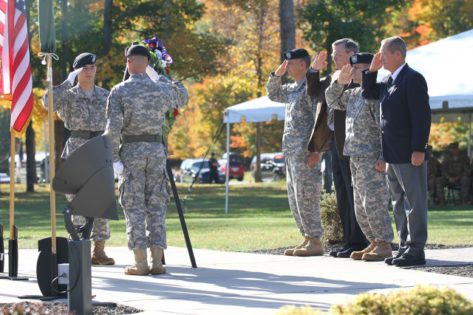
Battle of Mogadishu
On Oct. 3, 1993, Soldiers of 2nd Battalion, 14th Infantry Regiment, took part in one of the bloodiest battles American Soldiers had seen since Vietnam. The history of the battle has been commemorated in many accounts, including most notably the “Black Hawk Down” book and movie.
To remember the battle, one also must remember the reason U.S. forces were in Somalia in the first place.
Operation Restore Hope began Dec. 8, 1992, under the direction of a multinational Unified Task Force. The U.S. Army component Task Force Mountain was built around 1st and 2nd Brigades of 10th Mountain Division (LI), along with aviation, artillery and support assets.
During Operation Restore Hope, the division’s mission was to secure major cities and roads to provide safe passage of relief supplies to the starving Somali population. They saved hundreds of thousands from starvation, and by mid-February 1993, the division began the gradual reduction of forces in the country.
In May 1993, the United Nations assumed the task of securing the flow of relief supplies to Somalia, ending Operation Restore Hope, and marked the beginning of Operation Continue Hope.
During the months to follow, Somalia militia continued to attack humanitarian relief convoys and seize supplies for their local warlord leaders. On Oct. 3, 1993, Task Force Ranger undertook a raid to capture warlord leaders in Mogadishu.
When Task Force Ranger became pinned down during the raid, which became known as the Battle of Mogadishu, 10th Mountain Division provided a quick reaction force of infantrymen to rescue them. The battle became the longest sustained firefight by U.S. forces since the Vietnam War.
When the force began its exfiltration, some members of Task Force Ranger and 2-14 Infantry were required to move on foot because the vehicles were full. The movement has become known as the Mogadishu Mile.
To commemorate the actions of those men who fought during the Battle of Mogadishu, 2-14 Infantry, 2nd Brigade Combat Team welcomed more than 60 veterans and their Families to their 20th Anniversary Mogadishu Mile on Oct. 3 at Fort Drum.
The day began with 2-14 Infantry Soldiers and veterans conducting a Mogadishu Mile together and sharing the Golden Dragon history.
Lt. Col. Robert Fouche, 2-14 Infantry commander who recently returned from a deployment in Afghanistan with his battalion, started by welcoming the veterans and telling them how their actions and lessons learned serve as a template for their own training.
“Your actions in Somalia serve as an inspiration to us — the current Golden Dragons — and for many Soldiers across the Army,” he said. “The lessens that you guys learned there and brought back and shared with the rest of the Army here have been incorporated into our training cycles as we prepare to go to Afghanistan now.”
As the Soldiers made their way through their “mile,” they stopped periodically to listen to some of the veterans recount the events they experienced on Oct. 3, 1993.
Lt. Col. Michael Whetstone, then a captain who served as commander of C Company, took his Soldiers to the second Black Hawk helicopter crash site. Although they came under extremely heavy rocket and small-arms fire, they made it to where UH-60 pilot Chief Warrant Officer 3 Michael Durant and his crew were supposed to be.
Soldiers would later learn that Durant, a member of the 160th Special Operations Aviation Regiment assigned to Task Force Ranger, had been captured by a group of Somalis.
“We did not know how tenacious and ferocious they would fight or how many of them there were,” Whetstone recalled. “It was kind of bittersweet, because nobody was there (at the site). It was kind of weird in the middle of the night, calling out names (of) people we didn’t even know, but it didn’t matter. As Americans, we went there no matter what to find out if there was anybody there alive and police up whatever was left. We don’t leave anybody behind, ever.”
Retired Brig. Gen. Bill David was a lieutenant colonel and commander of Task Force 2-14 during the battle. He expressed his pride in the Soldiers who fought during the battle.
“When you think about it, that same funnel — that same cordon that the Rangers could not fight their way out of — 2-14 (Infantry Soldiers) fought their way in,” David remembered. “Nobody ran out of ammo, nobody fell out, and we didn’t have to carry anybody on our back because they failed physically. We had to carry people on our backs because they were wounded, but not because they physically failed.
“We do not leave anybody behind. Everybody who went in, came out,” he added.
After completing the Mogadishu Mile, a wreath was laid at the 2-14 Infantry memorial for Pfc. James H. Martin Jr., a former Golden Dragon, who was killed in action by a Somali gunman on Oct. 4, 1993, while he was firing an M-16 rifle to give cover to medics, and Sgt. Cornell Houston, a member of 41st Engineer Battalion, who was killed while fighting from the rescue convoy.
The Golden Dragons then proceeded to the 10th Mountain Division Operation Restore Hope / Continue Hope memorial ceremony, where Maj. Gen. Stephen J. Townsend, Fort Drum and 10th Mountain Division (LI) commander, took the podium.
“Our purpose today is to commemorate the division’s entire role and effort in Somalia to help the Somali people,” he said. “For over 15 months, the entire 10th Mountain Division rotated through deployments in Somalia, shouldering across that beleaguered country, operating and fighting along a spectrum of war from handling humanitarian aid one day to desperate close-quarter combat the next.
“The Golden Dragons, with the help from other division units, assembled and led an international quick reaction force to assist Task Force Ranger,” Townsend continued. “They made multiple attempts to get through and never gave up. I heard Brig. Gen. (Bill) David today and some of the other leaders that are here today tell those younger Golden Dragons that they would never stop their attempt. There was never a thought that they would not succeed.”
After the commanding general’s remarks, those in attendance rose for the rendering of honors, the playing of taps and “Amazing Grace,” and a moment of silence. Then guests and Soldiers paid their respects.
For the remainder of the day, current 2-14 Infantry Soldiers took the Mogadishu veterans on a tour of the post’s high-tech training areas that did not exist back then, from the Virtual Training Facility that has the Engagement Skills Trainer, where Soldiers can maintain effective marksmanship; to the Medical Simulation Training Center, where they train on combat life saving skills; to the Improvised Explosive Device Defeat Center, where Soldiers learn the latest in robotic mine identification and clearance.
“The Army today takes a back seat to nobody. You guys (have) got a lot of toys we did not have 20 years ago,” David said. “I think we had maybe two night vision devices per squad, and we had one GPS per company. We were still using grease pencils on maps. You guys have a lot of things we did not have back then.
“It doesn’t make your job in a lot of respects any easier, because we know combat is (like) a bar fight,” he added. “That will never change.”
For a deeper dive
 Soldier of Fortune Magazine The Journal of Professional Adventurers
Soldier of Fortune Magazine The Journal of Professional Adventurers


